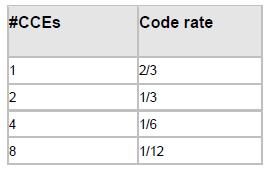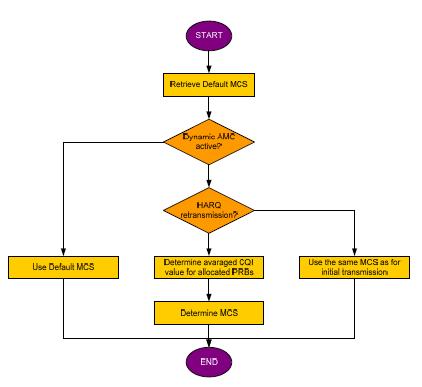The effective Eb/No and hence the spectral efficiency depend on BLER. However there are QoS requirements which also have to be considered. Taking both into account leads to a target BLER.
AMC is in use in order to tune BLER so that the target value is reached. Therefore when channel conditions change modulation and/or coding modifications might be needed.
Link adaptation for PDSCH
An initial MCS is provided by O&M (parameter INI_MCS_DL) and is set as default MCS. If DL AMC is not activated (O&M parameter ENABLE_AMC_DL) the algorithm always uses this default MCS.
If DL AMC is activated HARQ retransmissions are handled differently from initial transmissions ( For HARQ retransmission the same MCS has to be used as for the initial transmission).
An MCS based on CQI reporting from UE shall be determined for the PRBs assigned to the UE as indicated by the downlink scheduler. So the mechanism has UE scope with a frequency of several TTIs based on configurable CQI measurement intervals.
Link adaptation for PDSCH
In RL T the algorithm is based on overall signaling payload (control data volume) for all users and does not depend on the actual radio condition.
The adaptation is done on cell-basis and per TTI. In RL10 the code rate is selected for PDCCH resources (QPSK only) based on CQI reports. These CQI reports indicate the ‘CCE (Control Channel Elements) aggregation level’ and hence the coding rate.

The usage of PDCCH resources are based on channel condition and in addition on the availability of PDCCH resources into account. The feature may be enabled by O&M.

For AMC of the PUSCH a UE specific slow link adaptation ( 10-100ms) is applied. The decisions are based on BLER measurements.
AMC works independently of UL scheduler and UL power control. Interactions to UL PC and scheduler are result driven, i.e. to keep signaling load on eNodeB internal interfaces low, MCS is reported at the start of data transfer and only when there are changes of MCS. In case of long link adaptation updates and to avoid low and high BLER situations, the link adaptation can act based on adjustable target BLER values:
– “Emergency Downgrade” if BLER goes above a MAX BLER threshold (poor radio conditions);
– “Fast Upgrade” if BLER goes below of a MIN BLER threshold (excellent radio conditions).